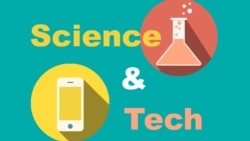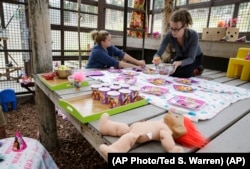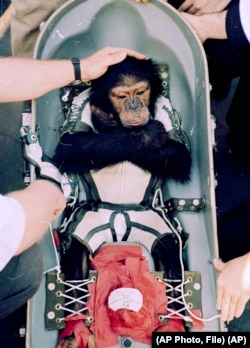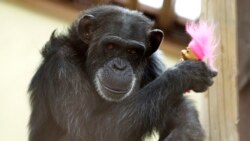Paper plates full of fruit, a colorful sign and dolls for children were all part of a birthday party recently in the American state of Washington.
The party was for a chimpanzee named Foxie.
Foxie has been living at the Chimpanzee Sanctuary Northwest in Washington since 2008. She was born in a Texas laboratory in 1976, and recently celebrated her 40th birthday.
Foxie is a rescue chimp. The party was a nice change from her painful past.
Used for medical research
For years, Foxie was used for medical research in hepatitis experiments. Hepatitis is the name for several diseases that affect the liver. The virus can be deadly in human beings.
Researchers operated on Foxie as a test animal. They performed biopsies, removing and testing her tissue for signs of the disease.
While at the laboratory, she gave birth to four chimps who were taken from her.
Diana Goodrich works at the Chimpanzee Sanctuary Northwest. On a windy day, she spoke about Foxie and the rescue program.
“She (Foxie) was really wary when she first came. Really kind of fearful and uncertain.”
Her story is similar to hundreds of other chimpanzees who have been used for medical research. Goodrich says the sanctuary has chimps that “have signs of depression and post-traumatic stress disorder.”
Chimpanzees are the closest relative genetically to humans. We share almost 99 percent of the deoxyribonucleic acid (DNA). DNA contains the genetic directions organisms need to develop, live and reproduce.
Chimps have been important in developing medicines. They also helped clear the way for astronauts to go into space. A chimp named Ham flew in space before the first man.
Declining use in research
But the use of chimpanzees in research has been shrinking in recent years. An Institute of Medicine report in 2011 said science had improved so much that most research on chimps was no longer justified.
Three years ago, the U.S. National Institutes of Health (NIH) said it was ending research on the animals.
Then, in 2015, the U.S. Fish and Wildlife Service declared captive chimpanzees “endangered” -- just like the chimps in the wild. This means any use of chimps that could harm or kill them would require a special permit.
Kathleen Conlee is with The Humane Society, a group that worked to end medical research on chimpanzees.
“The laboratories have now realized they don’t have a use for chimpanzees anymore so it’s in their interest financially to not be involved in the business of holding onto chimpanzees anymore.”
Moving chimps to sanctuaries
NIH officials are working with groups like Project Chimps and others to retire all of its apes to protected spaces in Louisiana and Georgia. The NIH said it wants its last chimpanzees to move to Louisiana by fall 2026.
Conlee says bringing an end to experimenting on chimps means it is a story with a happy ending.
“I think the most exciting thing about this campaign is that no other animal protection issue, you usually don’t see an end. There is an end in sight and a great ending for these chimpanzees.”
Now, homes need to be found for the more than 660 chimps who were once used in government research and private labs. That will cost a lot of money. After building and transportation costs, Conlee says housing a chimp will cost as much as $20,000 a year.
Foxie found her home in Washington State, but Diana Goodrich says finding homes for all the chimps is not easy.
“There's not space right now for them. So, it’s a matter of getting enough money to build and expand the sanctuaries that exist.”
Foxie lives with six other chimps. All were once used for hepatitis experiments.
The sanctuary will add two to four more chimps to Foxie’s group.
Meanwhile, Foxie seems to be happy with her “troll” dolls -- children’s playthings. The dolls looks like small people, with long, colorful hair and a face that looks a little like an ape. Goodrich says Foxie “immediately fell in love” with the first troll doll she saw.
She carries one around on her back like a baby. She cares for them and hugs them. Goodrich said Foxie is no longer afraid, and has turned out to be the peacemaker in her group.
I’m Anne Ball.
Anne Ball wrote this story for Learning English with information from a report by VOA's Kevin Enochs. George Grow was the editor.
We want to hear from you. Write to us in the Comments Section and visit us on our Facebook page.
Try this quiz to check your understanding of this story.
____________________________________________________________
Words in This Story
doll - n. a child’s toy that looks like a human figure
sanctuary – n. a safe place
decoration – n. something that is added to something to make it more attractive
hepatitis – n. a virus that causes disease that can be deadly
biopsy – n. a medical procedure that requires removing tissue from a body and examining it for disease
wary – adj. not having trust in someone or something
depression – n. a mental condition of feeling sad
post-traumatic stress disorder – n. a mental health condition that comes from a terrifying event, either by experiencing it or seeing it
ape – n. a type of animal, like chimpanzees and gorillas, that are closely related to monkeys and humans and are covered in hair and have a very short tail or no tail
















